Are your camera settings still stuck in auto mode? Auto mode is the fastest way to take a photo but offers little flexibility and creative control. You need complete control over the camera settings.
Camera settings affect several factors, from a photograph’s blur to its color. These settings include exposure, white balance, focus, drive mode, file type, etc. Our beginner’s guide to camera settings teaches you the basics and how to best adjust them!

- Master manual mode to capture moments you’re proud of.
- Overcome the frustration of missed shots with quick exposure settings.
- Benefit from visuals with hundreds of images and illustrations.
Camera Settings and Exposure
In auto mode, the camera chooses the settings for you. But the computer in your camera doesn’t have the same creative vision as you. You must understand and adjust exposure settings to turn your vision into a photograph.
Exposure settings determine how bright or dark the image is. You can adjust them in the following shooting modes:
- Program mode (P)
- Shutter priority mode (S or Tv)
- Aperture priority mode (A or Av)
- Manual mode (M)
- Bulb mode
Exposure settings also control motion blur, depth of field, resolution, and other factors you might not even consider. We often think of three key settings as the components of the exposure triangle. They are shutter speed, aperture, and ISO.
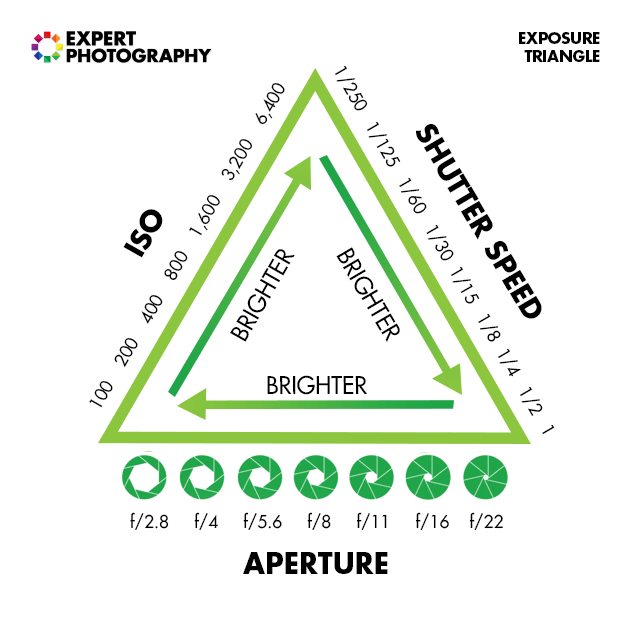
Shutter Speed
When the camera takes a photo, the shutter opens and closes to let light in to capture the image. Shutter speed determines how long the shutter stays open.
Slow vs Fast Shutter Speeds
A slower shutter speed lets in more light and creates a brighter image. A faster shutter speed results in a darker exposure. And it also reduces the amount of motion blur.
Shutter speed is indicated in fractions of a second. Cameras display a shutter speed of 1/1,000th of a second as 1,000. If it’s a full second (or longer), it’s written as 1″.
A fast shutter speed (like 1/1000 s) freezes most movement in the photograph. Only subjects moving very fast (relative to the frame) are slightly blurred. In situations like airshows or sporting events, prioritize shutter speed over other settings. Keep it very fast.
But faster shutter speeds limit the light coming into the lens. A relatively slow shutter speed (like 1/60 s) may be necessary in darker environments. This prevents the image from being too dark or underexposed.
Balancing Exposure and Blur
Choosing shutter speeds is a matter of balancing exposure and blur. If the subject is still or slow-moving, the shutter speed can be slow, like 1/60 s.
If the subject moves, like in a street scene or concert, you likely want a shutter speed of at least 1/250 s. Sporting events often require even faster shutter speeds.
If you can’t reach a shutter speed that is fast enough for your subject, raise the ISO and introduce more noise. Correcting noise is much easier than fixing a motion-blurred image during post-processing.
Keep in mind that blur comes from more than just a moving subject. If you set your shutter speed too low, the slight motion of your hands can blur the image. This is called camera shake.
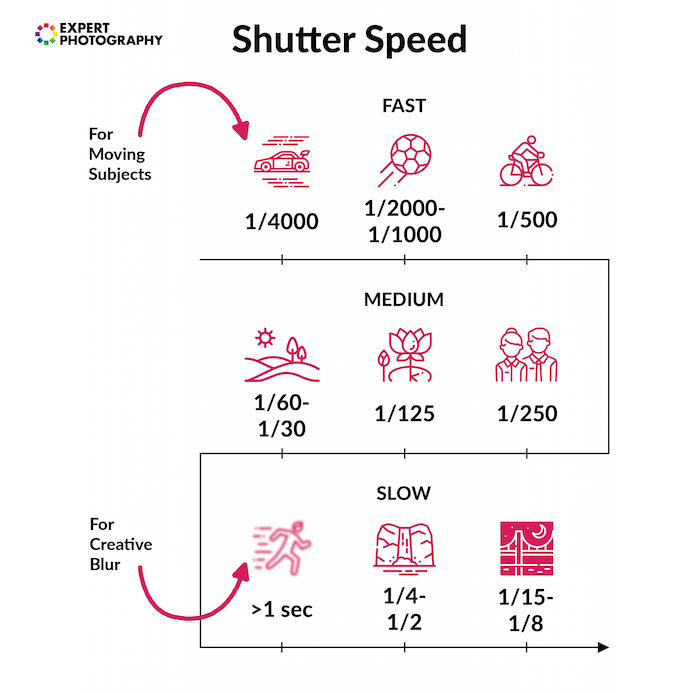
Reciprocal Rule
As a general rule, keep the bottom number of your shutter speed at or higher than your focal length. This is called the reciprocal rule. For example, if you shoot with a 50mm lens, you should use a shutter speed of at least 1/50 s.
Note that we’re referring to equivalent focal lengths. To calculate your real focal length, multiply it by your camera’s crop factor.
Long lenses exaggerate camera shake. When using a 200mm lens, you should use a shutter speed of at least 1/200 s. When using a tripod or monopod, you don’t need to worry about this rule for camera shake. And good optical image stabilization systems also reduce shake.
A quick note on resolution. If you have a high-resolution camera, the reciprocal rule may not be enough to keep your scenes sharp. A high-res sensor is more sensitive to camera shake. Experiment with your camera and the stability of your hands to know your camera’s limits.
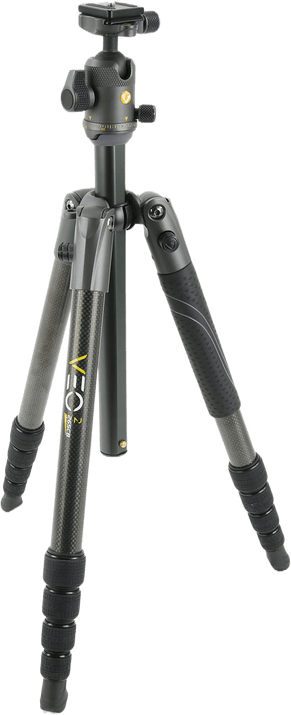
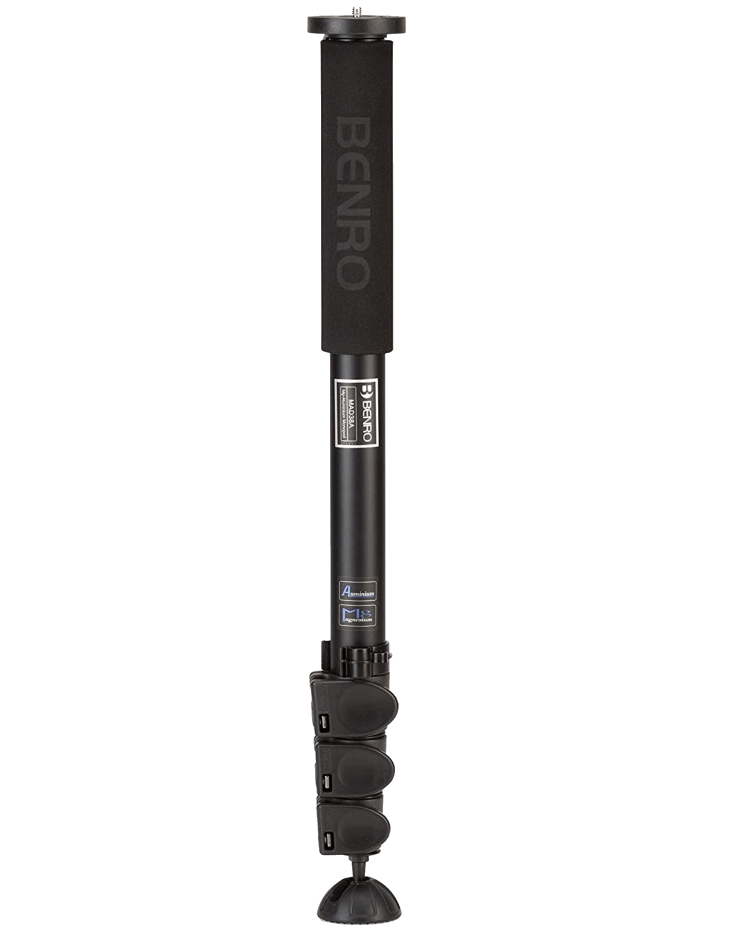
Aperture
A camera lens aperture controls the size of the opening in the lens. Like a larger window, a wider aperture lets more light reach the sensor, creating a brighter image.
We measure aperture in f-numbers. A low f-number (like f/1.2) is a wide aperture that lets in lots of light. A high f-number (like f/11) is a narrow aperture that lets in less light.
Aperture affects more than just the photograph’s exposure. It also affects depth of field, which refers to how much of the image is in focus. A photo with a shallow depth of field has a very soft or blurred background, while one with a large depth of field leaves more of the image in focus.
Like shutter speed, choosing the right aperture is a matter of balance. A wide aperture helps blur the background and draw attention to the subject. It can also balance a dark exposure caused by limited light or high shutter speed.
A narrow aperture keeps more of the photo sharp. This is good for taking a group photo or shooting a landscape. It also allows an intentionally slow shutter speed, like when blurring the motion of a waterfall.
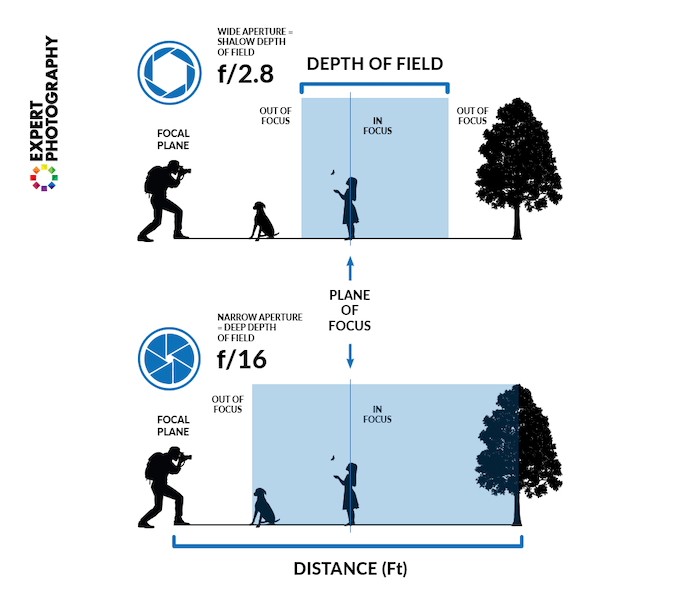
ISO
The final piece to the exposure puzzle is ISO. This setting determines how sensitive the camera sensor is to light. The tradeoff for increasing the camera’s sensitivity to light is that you get more grain in your photo.
A low ISO (like ISO 100) maintains image quality but isn’t very light-sensitive. A setting like ISO 3,200 is much more sensitive but more noise-prone.
ISO helps balance your shutter speed and aperture. You can raise your ISO with a narrow aperture to keep most of the scene sharp. If you are shooting in low light but need fast shutter speeds to freeze motion, you can increase ISO.
It’s best to keep ISO as low as possible for image quality, like when shooting on a bright, sunny day. But you can increase it when faster shutter speeds or a narrower aperture are more important.
ISO options and grain patterns are different among camera models. Try snapping a photo at each ISO setting on your camera. Determine which ISO is too high to use because of the resulting grain.
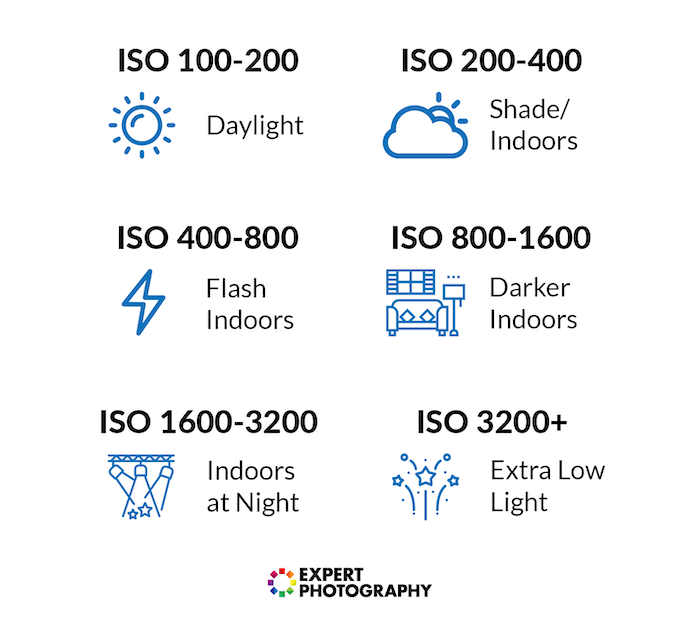
How to Change Camera Settings for Exposure
To change the shutter speed, aperture, and ISO, you need to switch the camera’s mode dial from “A” (auto) to “M” (manual). How do you find your camera settings? Each model is slightly different.
On most cameras, look for the dial next to your right index finger at the front. This adjusts the aperture. The dial at the back of the camera by your right thumb adjusts the shutter speed.
Some cameras only have one dial. In this case, press and hold the “Fn” (function) button to switch the dial’s function between shutter speeds and aperture. ISO is adjusted through a shortcut button or sometimes the camera menu.
Shooting Modes
Manual mode (M) isn’t the only option for adjusting camera settings. Bulb mode (B) is similar to manual mode, with one important distinction.
In bulb mode, the shutter speed is not predetermined. You can connect an external release (or press and hold the shutter button). This lets you set the shutter speed as long as you wish. It’s handy when shooting long exposures.
You adjust the shutter speed in shutter priority mode (S or Tv), and the camera chooses the aperture for you. In aperture priority mode (A or Av)), you choose the aperture. The camera chooses the shutter speed for you.
In program mode (P), you can use the dial to switch between suggested shutter speed and aperture pairs. The camera still determines the proper exposure in S, A, and P modes. You can use the exposure compensation button to brighten or darken the image.
These semi-auto modes are excellent for learning. They are also practical in scenarios with moderately bright, quickly changing light.
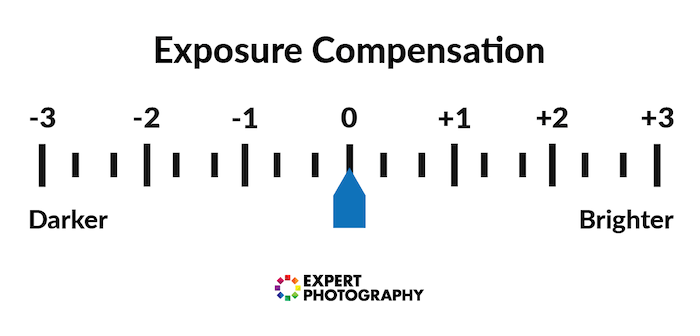
White Balance Settings
Light comes in different colors. We don’t realize it because our eyes adjust. But cameras don’t have the same ability to adjust to the different colors of light. If your images turn out too blue, yellow, green, or purple, the problem is the white balance.
Auto white balance (AWB) lets the camera adjust settings for you. It works well. But manually adjusting the white balance will correct the issue if the image’s color is off.
White balance settings are easy to understand because they are named after the type of light. Choose cloudy for taking photos on a cloudy day. Choose fluorescent for taking photos under fluorescent lights. And so on.
The goal with white balance is to keep white objects as true white in the photograph. You can also set the white balance manually using temperature settings. A more advanced solution is to photograph a white object or color card.
Changing the white balance settings differs from camera to camera. Look for a shortcut button marked WB or the option in the camera menu. If you’re unsure, consult your camera’s user manual.
If you’re shooting RAW, white balance is not a huge concern. It’s one of the few settings that isn’t “baked into” your image files. So, you can change it non-destructively during editing. But if you’re shooting a JPEG or video, it’s important to set it correctly on the spot.

Focus Settings
In autofocus (AF) mode, a camera focuses on what it thinks the subject is. Often, it selects whatever is closest to the camera.
But what if you don’t want to focus on the object closest to the camera? And what if the subject is moving quickly? Selecting the right focus settings increases your odds of getting a sharp shot every time.
Focus Area Modes
Focus area modes tell the camera which part of the image to focus on. Focus modes vary a bit by brand. Most cameras have at least the following autofocus area modes:
- Auto-area AF is the default autofocus setting. The camera uses this setting in auto mode. Without user input, it chooses from the entire image area and decides what to focus on.
- Single-point AF mode focuses on one small point determined by the user. You move the focal point using the arrow keys or joystick to tell the camera where to focus.
- Dynamic or AF Point Expansion lest the user choose a single point. It then uses the surrounding focal points if the subject moves. This is less specific than a single point but more custom than the auto area. It works well for moving subjects.
- Tracking AF or 3D AF lets the user select the subject. It then tracks that object as it moves. This mode can sometimes fail if the subject leaves the frame or there isn’t much contrast between the subject and the background.
Some cameras also offer face AF or eye AF. This automatically looks for an eye or face to focus on.

Continuous or Single Autofocus
Autofocus camera settings tell the camera where to focus. They also instruct the camera on how often to focus. These settings are essential for getting sharp, focused action shots.
In single (AF-S or One Shot) mode, the camera focuses when the shutter button is pressed halfway. This mode is good for still subjects. If the subject moves, the camera won’t refocus, and the image will be out of focus.
Continuous (AF-C or Al Servo) focus continually adjusts the focus as long as the shutter button is pressed halfway. That means the focus is constantly adjusted until the image is taken. This mode lets moving subjects remain in focus. But it’s best to avoid it for stationary subjects.
AF-A or Al Focus AF is an automatic focus mode that switches between AF-S and AF-C. In this mode, the camera tries to determine whether the subject is moving. It’s good for beginners. But it’s not as accurate as switching between AF-S and AF-C yourself.
Release Mode Settings
When you press the shutter, do you want the camera to take one image or two? You can set that in the camera’s release (or drive) mode.
Burst mode takes photographs as long as the shutter button is pressed. This is unlike the single-shot mode, which takes one image each time you press the shutter release.
Some cameras have more than one burst mode—a fast mode and a slower mode. Burst mode is excellent for photographing action and perfecting the timing of a shot. But using the burst setting will fill your memory card faster.
The release mode settings often include other options, like a self-timer and burst mode. The self-timer is great for taking a selfie in front of the camera. It also helps prevent camera shake when using a tripod for a long-exposure image.

Image File Type Settings
Most cameras also offer different options for how the images are saved. You can dive into custom options, like how each image is named. The most important file type setting to understand is the difference between JPEG and RAW.
A JPEG is the most typical digital photograph and the default file type. JPEGs can be processed in-camera and ready to share and print from the camera.
JPEGs are also smaller than RAW files. They take up less space on a memory card and won’t slow a camera down like RAW files sometimes can.
RAW photographs are unprocessed. You can’t share an RAW file straight to Instagram. But this file type opens up more editing options.
If you messed up the white balance, you can fix that with a RAW file without affecting image quality. RAW files are also better for making minor exposure adjustments. They store a larger dynamic range, which can create better contrast and vibrance.
You can’t fix major exposure errors and blur in RAW. It’s best to get as much right as possible in-camera. If you plan on editing those photos, RAW is the best file type.

Conclusion: Camera Settings
Using the correct camera settings can prevent common issues like blur and underexposure. Your settings give you the tools to capture creative imagery. Learning digital photography settings can feel daunting at first. Practice each setting individually, and then move on to the next.
It is essential to build an understanding of the different camera settings. With this knowledge, you’ll know how to capture any potential image that comes your way. You can learn more about camera settings with our Photography for Beginners course.

- Learn to effortlessly set up your camera for any situation.
- Master the art of selecting the perfect exposure every time.
- Discover 10 composition rules that elevate your photos instantly.

